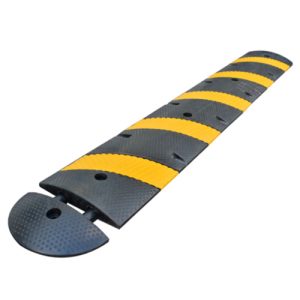Speed bumps are temporary, lightweight barriers that reduce vehicle speeds by a set amount. They are ideal for temporary installation on public roads. They can also be removed or concealed during periods of snow. Although speed bumps are highly effective at reducing traffic speeds, the use of speed humps has not been widely adopted.
What needs to be done before installing speed bumps?
In order to install speed humps, a citizen must submit a petition stating that he/she wishes the city to install them on a street. In addition, a citizen representative must gather funds to pay for the speed humps. Once a citizen-led campaign has collected the necessary funds, the county will schedule the installation between April and September.
Residents will need to collect signatures on the petition and provide the county with data regarding traffic volume and speed on the street in question. If the majority of citizens sign the petition, installation will happen.
Although they are often used to slow traffic, speed humps can also be useful for emergency vehicles. Since they slow down vehicles, they may not slow down the cars traveling at high speeds. However, they are effective in traffic checks and help to keep cars off of a specific road.
However, these traffic control devices are not the only solution for improving safety on roads. A variety of traffic control products are available from roadway and security solutions.
| SKU | Description | Length | Height | Width | Weight |
|---|---|---|---|---|---|
| SB206FT | 6 Ft Speed Bump (1) 6′ Section With no End Caps | 72″ | 2″ | 12″ | 48.40 |
| SB207FT | 7 Ft Speed Bump (1) 6′ Section + (2) End Caps | 86″ | 2″ | 12″ | 55.40 |
| SB213FT | Single Lane 12 Ft Speed Bump (2) 6′ Section With no End Caps | 144″ | 2″ | 12″ | 96.80 |
| SB219FT | Double lane 19 Ft Speed Bump (3) 6′ Section + (2) End Caps | 230″ | 2″ | 12″ | 152.20 |
| SB225FT | 25 Ft Speed Bump (4) 6′ Section + (2) End Caps | 302″ | 2″ | 12″ | 200.60 |
| SB2ECAP | End cap | 7′ | 2′ | 12′ | 3.50 |
| SKU | Description | Length | Height | Width | Weight |
|---|---|---|---|---|---|
| SB3039I | 39″ Speed Bump (1) 39″ Section With no End Caps | 39″ | 2″ | 13.7″ | 36.20 |
| SB3117I | 117″ Single Lane Speed Bump (3) 39″ Sections With no End Caps | 117″ | 2″ | 13.7″ | 108.60 |
| SB3137I | 137″ Single Lane Speed Bump (3) 39″ Sections + (2) End Caps | 137″ | 2″ | 13.7″ | 124.20 |
| SB3234I | 234″ Double lane Speed Bump (6) 39″ Sections With no End Caps | 234″ | 2″ | 13.7″ | 217.20 |
| SB3254I-2 | 254″ Double Lane Speed Bump (6) 39″ Sections + (2) End Caps | 254″ | 2″ | 13.7″ | 232.80 |
| SB3ECAP-2 | End cap | 10″ | 2″ | 13.7″ | 7.80 |
| SKU | Description | Length | Height | Width | Weight |
|---|---|---|---|---|---|
| SH1018I | 18.75″ Speed Bump (1) 18.75″ Section with no End Caps | 18.75″ | 1.25″ | 2″ | 22.20 |
| SH1112I | 112.5″ Single Lane Speed Bump (6) 18.75″ Sections with no End Caps | 112.5″ | 1.25″ | 2″ | 133.20 |
| SH1128I | 10 Ft Single Lane Speed Bump (6) 18.75″ Sections + (2) End Caps | 128.5 | 1.25″ | 2″ | 148.80 |
| SH1225I | 225″ Double Lane Speed Bump (12) 18.75″ Sections with no End Caps | 225″ | 1.25″ | 2″ | 266.40 |
| SH1241I | 20 Ft Double Lane Speed Bump (12) 18.75″ Sections + (2) End Caps | 241″ | 1.25″ | 2″ | 282.00 |
| SH1ECAL | LEFT End Cap | 8″ | 1.25″ | 2′ | 7.80 |
| SH1ECAR | RIGHT End Cap | 8″ | 1.25″ | 2′ | 7.80 |
| SKU | Description | Length | Height | Width | Weight |
|---|---|---|---|---|---|
| SH2019I | 19.75″ Speed Bump (1) 19.75″ Section With no End Caps | 19.75″ | 2″ | 3″ | 48.00 |
| SH2121I | 10 Ft Single Lane Speed Bump (5) 19.75″ Sections + (2) End Caps | 121.75″ | 2″ | 3″ | 273.00 |
| SH2240I | 20 Ft Double Lane Speed Bump (11) 19.75″ + (2) End Caps | 240″ | 2″ | 3″ | 561.00 |
| SH2ECAL | LEFT End cap | 11.5″ | 2″ | 3′ | 16.00 |
| SH2ECAR | RIGHT End cap | 11.5″ | 2″ | 3′ | 16.00 |

6′ Economy Recycled Rubber Heavy Duty Speed Bump

Recycled Rubber Speed Hump – Yellow / Black Single Lane or Double Lane

Premium Reclycled Rubber Safety-Striped Speed Hump – Reflective Rubber

Heavy Duty Rubber Speed Hump – Yellow / Black – Low Profile Speed Bump
Improving safety of roads
When placed properly, speed bumps can improve safety and reduce the risk of accidents. The installation of these devices requires a thorough study of traffic conditions in order to determine if they are appropriate.
They should be placed in strategic locations and are often spaced 275 feet apart or 90 yards apart. The height ranges from three to six inches. In general, speed humps are installed at least three feet above ground level, and should not be placed too close to drainage or intersections. They can also be installed under street lighting if needed.
Many people ignore speed bumps or try to drive around them. Others choose to change their route or simply ignore them. And then, some people simply drive slowly over them. In such cases, the vehicle might even cause minor damage to the vehicle.
This is why civil engineers have worked so hard to implement speed bumps as a safety precaution. However, despite the benefits of speed bumps, not everyone appreciates their existence. So, when a Speed Bump is present on a road, it is a good idea to consider its purpose.
Final words
There have been a number of studies that have looked at the effects of speed bumps. One study by the University of Connecticut found that the presence of these devices adversely affected emergency vehicle response times and was a public nuisance.
In contrast, this study also found that speed humps may cause damage to vehicles traveling at normal speeds. So, how do you prevent speed bumps? Here are three ways to implement speed bumps safely. You can make them more effective!

